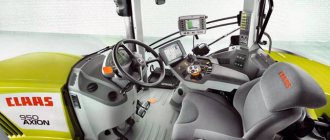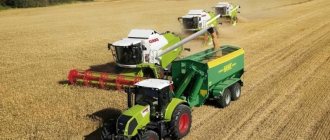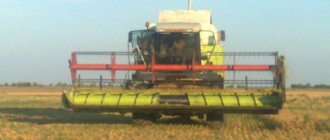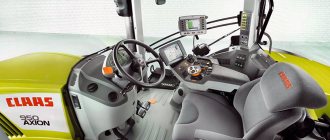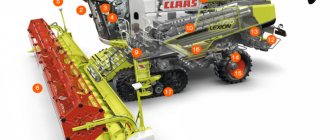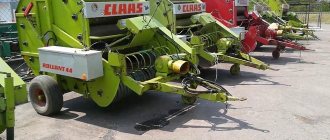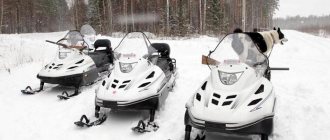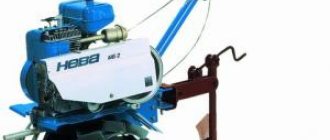The presented new product will be of interest to potential buyers primarily due to the fact that its design combines large and small disks. A caveat should be made right away - this combination is available only in the older model, and the younger version only has small disks, although this has virtually no effect on the efficiency of the equipment. In practice, this allows you to optimize the harvesting process and reduce losses. At the same time, the productivity of the header has also increased, and the level of reliability has increased significantly due to a well-thought-out design.
The design of the ORBIS 600 SD corn header is primarily notable for its pendulum-type frame, in which the T-shaped panels were modified - as a result, this made it possible to reduce the weight of the attachment, which significantly affected the level of its wear resistance. The manufacturer also cleverly thought out the technology for folding the attachment, due to which the combine can move from the transport position to the working position literally in a matter of seconds. The reverse process takes the same amount of time.
Main advantages and features of the header
The ORBIS 600 SD model attracts particular attention due to the fact that the flow of the harvested corn mass looks like a funnel. Due to this, high quality processing is ensured and the amount of forage crop losses is significantly reduced. This is especially true when working in fields where the sowing was done unevenly for one reason or another.
As additional attachments for the grain harvester, special modules are provided that allow you to harvest even a fallen crop - this can significantly reduce the time and money spent on harvesting. This is a very important functionality, since corn is one of those crops that is characterized by a fairly high difficulty in harvesting after the bulk of the crop has settled on the ground.
The knives themselves are now distinguished by their sickle shape, which allows using such a header to harvest not only corn, but also many other agricultural crops. This result is achieved due to a high-quality and very precise cut - the company’s engineers approached the development of blades with the most balanced and thoughtful approach.
Due to the impressive working width of the header, which reaches six meters in the younger model, the harvesting process can be significantly accelerated, which is also very important for the combine operator, since the whole process becomes less exhausting and difficult. The same applies to the automation system for collecting the header into the transport position, since the operator does not need to perform all these operations manually, paying more attention directly to the work process.
CLAAS presents the new CONVIO FLEX header with flexible draper cutting unit. This solution not only provides ideal threshing of such traditional crops as grains and rapeseed, but also helps to achieve high efficiency when harvesting soybeans, peas, and cereal grasses. Auxiliary systems that control the height of the cutterbar and reel, together with other innovative solutions in the design of the header, make the operator’s work easier and at the same time minimize crop losses. The new attachments are installed on combine harvesters and have two working width options for the Russian market: 10.8 m and 12.3 m. The external press service of CLAAS reports this.
The conventional CONVIO header has a rigid blade bar and table, while the CONVIO FLEX has both of these components, as well as the side conveyor belts, that can bend. Thanks to this, the cutting device follows the contour of the ground, descending to the lowest cutting height across the entire working width of the header. This allows low-growing crops such as soybeans to be harvested with minimal loss by cutting the stems close to the ground. For harvesting tall grain crops, the CONVIO FLEX can be used like a conventional reaper with a rigid cutting device and table. In areas with laid down crops, the terrain copying mode is activated by pressing one button, due to which crop losses are minimized over the entire working width of the header.
Photo: CLAAS external press service
Both the CONVIO FLEX and the regular CONVIO header are excellent for harvesting rapeseed. At the customer's request, additional specialized equipment for harvesting rapeseed is supplied, such as left and right feed augers with a diameter of 425 mm and rapeseed knives, which can be attached and dismantled without any tools. To reduce losses to a minimum, there is a rubber tray underneath the central conveyor, and the raised rear wall of the cutting device prevents losses from bouncing grains.
A number of automatic functions implemented in the CONVIO FLEX and CONVIO headers are integrated into the CEBIS on-board terminal, which provides the operator with the most comfortable work. Warning signals that the conveyor belt is slipping or that it is about to stop allow you to intervene in the work process in advance, even in dusty conditions or at night. The reverse function has two operating modes. Pressing a button on the control joystick starts movement in the opposite direction of the central and side conveyor belts. This can be done directly while the combine is moving and minor problems can be easily eliminated. A toggle switch on the armrest reverses the reel, center belt, feed auger and feeder.
Photo: CLAAS external press service
The CONVIO FLEX header also has four operating modes and the AUTO CONTOUR automatic cutterbar height adjustment system: 1. In the grain harvesting mode, the cutting device and the header table do not bend. 2. When there are separate areas in the field with laid crops, the operator can, without stopping the combine, switch the operation of the header from hard to flexible mode by pressing a button. 3. In flexible mode, the knife bar follows the contour of the soil using follower arcs. With a total flex range of 225mm (90mm up and 135mm down from neutral), CONVIO FLEX can adapt to virtually any ground surface. 4. In AUTO CONTOUR FLEX mode, the cutting unit uses sensor data to constantly determine its optimal position to simultaneously maintain crop flow and follow the soil topography, providing the lowest possible cutting height. As a result, when harvesting low-growing crops, losses on the header are minimized.
Photo: CLAAS external press service
The new reel design with innovative curved guides guarantees optimal crop flow under all harvesting conditions. This concept effectively prevents the stems from wrapping around the reel. When harvesting fallen crops, the reel lifts the stems before they are cut. This is especially true when harvesting grains, as it significantly reduces grain losses. The hydraulic drive of the header, as well as automatic torque control, prevents fingers from digging into the ground. This auxiliary system always allows the operator to adjust the operation of the reel so that the mass flow is always maintained at a given level.
The new CONVIO and CONVIO FLEX headers will be available on the Russian market from the beginning of 2022.
Share material
Constructive decisions
Since the main goal of the designers was to improve the design of the header for more efficient harvesting, the main feature of the ORBIS 600 SD header is that the bulk of the harvested crop is fed to the pressing rollers, which are located strictly in the center - the harvest goes from the edges to the middle due to a special design side small disks. The manufacturer also paid attention to other technical features:
- Optimization of the work process taking into account the weight of the attachment, as well as the dynamic load to which it is subjected during the harvesting process.
- The ability to choose between two positions of the pendulum frame, which allows you to work effectively on various types of soil, thereby leveling the level of wheel subsidence. Thanks to this, the cut is made at the same angle.
- Relief copying system. AUTO CONTOUR technology accurately recreates the terrain allows you to determine the level of inclination across the entire width of the header, which allows you to exercise full control over lateral compensation. It is noteworthy that this technology is available in the younger model only as an option, but in the 750 series headers it is provided as standard.
- T-shaped modular panels are designed to maximize the efficiency of the cutting elements. This also allows you to avoid clods of earth getting in during the work process, thereby ensuring the relative “purity” of the harvested crop. At the same time, the panels themselves are pre-hardened under pressure, which makes them more wear-resistant.
Another important feature of the panels is that they effectively protect transmission elements from any physical influences.
CLAAS: Practical advice for making corn silage SHREDLAGE®
By the beginning of the forage harvesting season, CLAAS experts studied both foreign and Russian experience in using the technology for making corn silage using SHREDLAGE® technology. For the analysis, we took medium-sized farms with a milking herd of 500 to 1000 heads, where, using this technology, results of 10-13 thousand kg of milk per head per year were recorded. At the same time, the share of corn silage in the main feed was 75-85%, and the rest was grass haylage. Based on the results of the survey of farmers, their main recommendations were systematized.
In all cases, a CLAAS JAGUAR 950 combine with a 10-row ORBIS header with a working width of 7.5 m was used for harvesting work. This combination provided a productivity of about 150-200 tons of corn per hour or up to 3.5 tons of feed per minute. The key was to set up the chopping drum and corn cracker correctly. In the first case, before starting work, it is imperative to check the condition and settings of the knives and shear bars, and replace them if necessary. With a dry matter content of about 30-35%, the cutting length should be 22-24 mm; when harvesting less wet corn, the cutting length should be reduced to 18 mm.
The main thing when setting up a corn cracker is to adjust the gap between the rollers and the difference in their rotation speed. To achieve optimal quality of material splitting, it is recommended to keep the gap minimal - 1-1.5 mm, the ratio of rotation speeds should differ by 50%. This makes it possible to exclude large, coarse stems, as well as other bulky parts of the plant, from the harvested silage mass. Also, as with knives, it is extremely important to monitor the wear on the corn cracker rollers. Another significant point is the control of cutting quality when moving from one field to another and when changing the dry matter content.
Silage can be laid using SHREDLAGE® technology in both trenches and mounds. It is important to compact evenly along the entire length of the trench. To achieve the best result, when selecting the weight of a rammer, you should focus on a coefficient of 0.3 tons of machine for every ton of green mass delivered per hour. Those. with a combine harvester productivity of 150 t/hour and logistics built for this, a tamper weighing about 50 t is required. The process of compacting the silage mass can be carried out in two stages: after unloading the trailer, the first tamper evenly distributes the mass, and the second one deals exclusively with compaction. The next layer can be laid only after there are no loose spots left on the surface of the previous one. When laying in a trench, it is important that the height of the silage mass does not exceed its wall. At the end of compaction, the silo trench or mound must be carefully covered with a protective film.
“The main thing that every farmer using SHREDLAGE® technology needs to remember is that no matter how perfect the JAGUAR combine and the corn cracker installed in it are, the quality of the feed depends on compliance with all technological parameters. Therefore, it is important to pay attention specifically to the quality of the workpiece, and not to the pace of work performed. And if all technological conditions are met, one of the main positive economic results for farms that switched to feeding animals with SHREDLAGE® feed is a significant increase in the indicator “Income Over Feed Cost” - IOFC (Income Over Feed Cost), which is achieved due to an increase in milk yield, a decrease overall costs for basic feed and improved herd health,” comments Ralf Henke, Head of Product Management for grain and forage harvesters at CLAAS.
About CLAAS
CLAAS (www.claas.com) was founded in 1913 as a family business and is now one of the world's leading manufacturers of agricultural machinery. The company, with its head office in the Westphalian town of Harsewinkel, is the European market leader in combine harvesters. CLAAS also retains its global leadership in the field of self-propelled forage harvesters. CLAAS is a leading company in the global market for agricultural machinery in the area of tractors, as well as agricultural presses and forage equipment. The company's product range includes the most modern information technologies in the field of agriculture. Today, CLAAS employs approximately 11,000 people worldwide. Turnover for the 2022 financial year amounted to 4 billion euros.
The company has been operating in Russia since 1992. In 2003, the production of grain harvesters began. Currently in Krasnodar it is one of the four largest among the 13 manufacturing enterprises of the concern around the world. The plant produces TUCANO grain harvesters and AXION, XERION tractors.
Sales of equipment are organized through a sales office in Moscow with the participation of 18 sales partners who operate throughout Russia.
Additional benefits
The folding technology mentioned above is also worthy of special attention because its efficient operation significantly increases the level of labor efficiency. Folding occurs in such a way that the side modules move to the center, making the entire structure more compact and maneuverable during transportation. When assembled, the width of the structure is only three meters, which gives two significant advantages:
- Excellent visibility during transportation due to its compact size and relatively low height;
- no need for additional documents when moving on public roads.
Additionally, the manufacturer has provided auxiliary control systems during transportation, which can be controlled directly from the combine cabin. The technology itself makes it possible to reduce the load on the traction vehicle and makes it possible to move along roads at speeds of up to 40 km/h.
From an automation point of view, the header model also has excellent performance, since a special communication module transmits all the necessary data to the on-board computer of the combine. At the same time, all parameters are preserved even when the attachments are changed - this also greatly improves labor efficiency.
